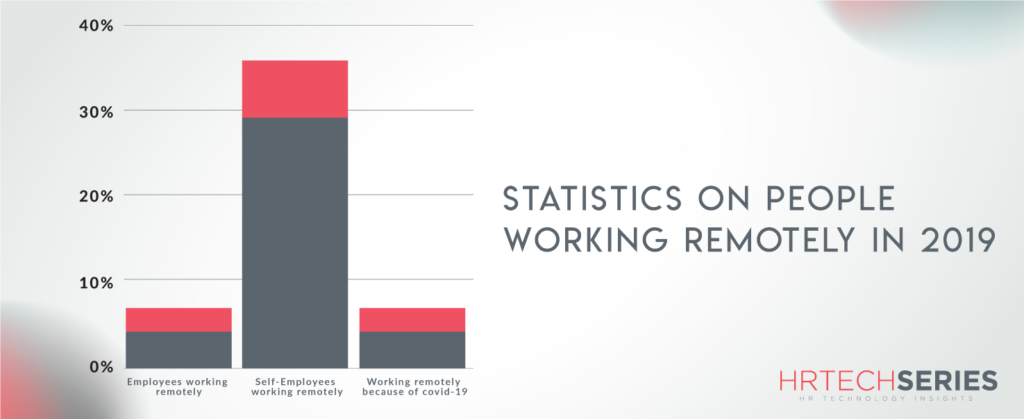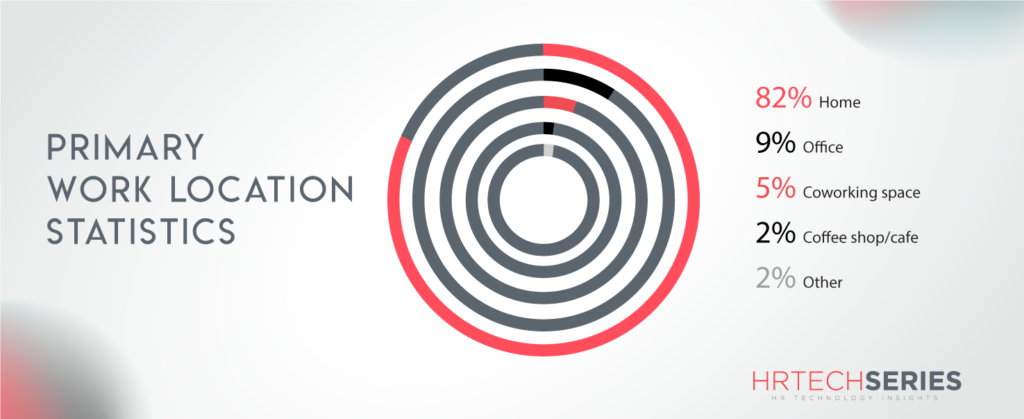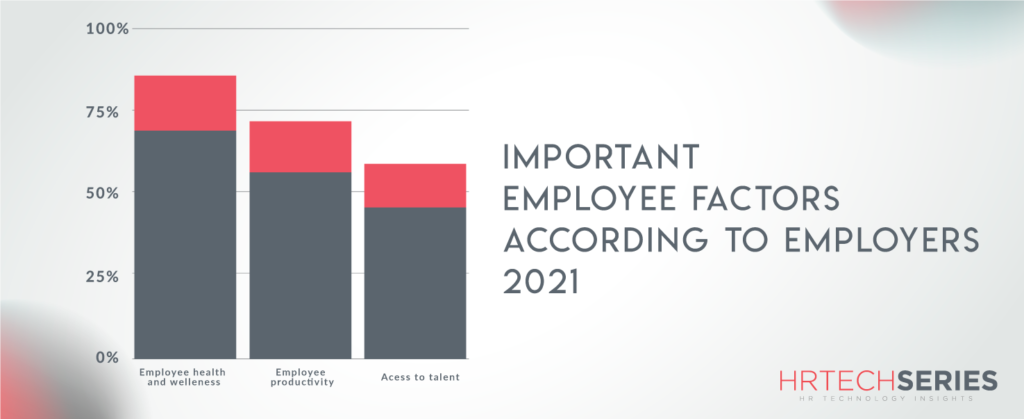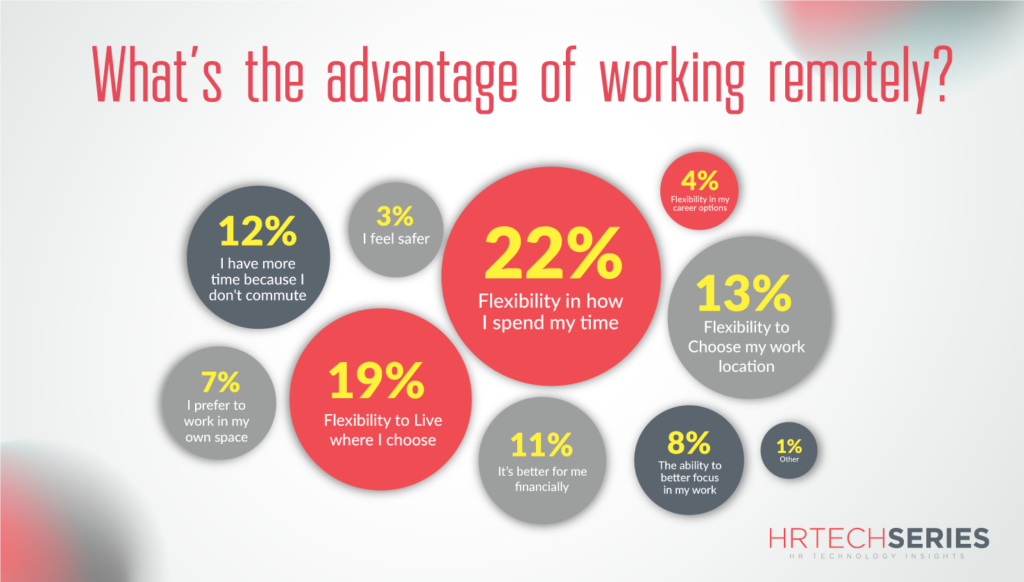The future of work is unpredictable. According to The 2023 State of Remote Work report by Buffer, 98 percent of the respondents would “recommend” remote working to others in 2o23. Uncertainties in job stability due to rapid infusion of cutting-edge technologies such as Artificial Intelligence and Automation have put many current employees in a delusional state of mind. Remote work in 2023 and coming years depend on how fast employers digitize their current enterprise technology stacks, and reorganize organizational structure for better pay and growth.
What began as a drastic response to the pandemic’s immediate and broad disruptions has evolved into a comprehensive assessment of staff productivity, management, and work-life balance. In reality, 29% of corporate executives have taken no steps to assess productivity remotely. When asked what the most important worry of company executives is, 30% said it is sustaining corporate culture. Additionally, 61% of company leaders have introduced more regular manager-employee check-ins in order to precisely monitor employees’ status. To address the aforementioned questions and emphasize the theme, we will trace the historical course of events beginning before and after the epidemic. Furthermore, we will examine modern employees and their workplace flexibility, perspectives, and beliefs.
The New Normal
Remote Work Before Covid-19
According to 2019 American data, just 5.4% of employed workers worked remotely. Furthermore, 36% of self-employed workers worked from home. Nevertheless, according to ILO figures, just 7% of the global population was working from home before the epidemic.
Additionally, businesses emphasized team development and making solid everyday ties with their personnel. Each employee’s productivity was assessed not just by the amount of work completed each day, but also by how much time they spent socializing with the team. Did you believe that only three years ago, the majority of the world’s population went to work every day?

After Covid-19
We can’t go on without addressing the time period of COVID-19. About 70% of full-time workers worked from home. According to an Upwork poll, 61.9% of employers are planning more remote work now and in the next few years as a result of COVID-19. It is worth noting that, following the epidemic, remote employees saved an average of 40 minutes per day on commuting. So what is the current situation?
In 2022, 16% of organizations will be 100% remote, while 44% will not allow remote work. 27% of employers, on the other hand, have experienced higher corporate productivity

Statistics on Remote Work for 2023
71 percent of the employers are “permanently” switching to some amount of remote work.
Starting with numbers from 2021, workers reported that 90% of employees who worked from home during the pandemic felt they were just as effective working remotely as they were in the office. Working remotely after the pandemic would also make 84% of employees happier, with many even prepared to accept a salary loss.
According to another Owl Labs study result, remote employees are happier and would be more willing to stay in their positions longer. According to one study, remote employees are 22% happier than those who work in an onsite office environment. Furthermore, remote employees are said to be less stressed, more focused, and have a better work-life balance. People are choosing more flexible working hours as the trend of working remotely grows. Furthermore, 69% of millennials would forego some job advantages in exchange for a more flexible working environment. Businesses’ largest concern, as previously stated, is that they are unable to totally manage their staff while working. On the other hand, those at the workplace are more likely to engage with one another and become quickly sidetracked. It is one of the reasons why 78% of remote employees think they prefer to work from home to avoid distractions.

The influence of remote work in the business sector is undeniable. According to Upwork, 36.2 million individuals in the United States will be remote by 2025, a 16.8 million increase over pre-pandemic estimates.
Additionally, as per Owl Lab’s 2022 State of Remote Work study, if WFH is no longer an option, two-thirds (66%) of employees would immediately begin seeking a job that offered flexibility, and 39% would just resign.
Remote employment is standard and will become more so in the coming years. To ensure that this trend continues, firms must work on developing strong remote company cultures that are simple for employees to traverse.
What Employees Want
Due to its flexibility, remote work can have a variety of organizational structures, depending on the business or personnel. This section delves into the specifics of people’s remote work, what collaboration means to them, and how organizations will help remote employees in 2023.
The vast majority of respondents (82 percent) admitted to working from home. Compared to 2022, when 59 percent of respondents indicated they were working from home, this was a huge increase.
The patterns we’ve observed throughout the years are consistent with this data. In 2018, 78 percent of people reported working from home; in 2019, 84 percent reported doing so.
In order to learn more, we probed a bit further and asked participants which room they used for working from home. A little over one-third (37%) claimed to have an office area dedicated to their business, while 21% claimed to do it from their bedroom. 14 percent of participants stated they moved from room to room while working, while 20% said they work from their living room. Just 2% of respondents to the study provided alternative characterizations, while 2% of survey respondents indicated they do not work from home at all.
Although the office received the most responses (37%), the majority of people who work from home (45%) use a multi-functional space such as the bedroom, kitchen, or living room.
The survey company wanted to learn more about the subtleties of remote work, especially because there have been so many changes over the years as some firms have gone totally remote while others have stressed hybrid work. Here is the present state of affairs for remote employees:
More than half of all workers (64%) are completely remote. This is a huge increase from 2022 when the figure was 49%. Every other hybrid setup category is lower this year than last.
This year, 71 percent of people stated they want a totally remote structure, up from 49 percent last year. This might be because more people have had hybrid work experiences and recognize its benefits. Other than the option of working remotely first and not having to come into the office on a regular basis, very few people chose hybrid solutions.
The debate has raged over whether the move to remote employment, which began in 2020, will be permanent. We asked respondents if their employer allowed some level of remote work on a permanent basis, and we received a similar result as last year: 71 percent of organizations accept some form of remote work on a permanent basis. Just 8% of respondents indicated their organizations do not permit any type of remote work.
How Remote Work Affects Productivity and Stress
According to the previously cited Owl Labs research, The Status of Remote Work, remote work has no effect on productivity levels. Working remotely makes 62% of workers feel more productive, while only 11% feel less productive.
Although the brick-and-mortar workplace has traditionally been seen as the most productive environment, evidence reveals that productivity is dependent on the sort of activity people are engaged in. Employees believe that the workplace is the most productive location for certain activities such as meeting new people, managing others, and holding team meetings.
Research on stress and burnout at work indicates that these issues have gotten worse over the past two years, with 45% of employees reporting an increase in their level of stress at work from the previous year. Although 58% of workers are worried about an upcoming recession, work-related stress is not the main cause of stress for them.
Does Remote Work Foster a Diverse and Inclusive Workplace
People all across the world may now obtain respectable jobs without being constrained by location, thanks to remote work. This idea has made it feasible for people all across the world to reach the workforce in ways that were not before conceivable. As a result, remote labor is assisting in resolving societal problems.
According to statistics from the Bureau of Labor Statistics, Bloomberg reported in late 2022 that 5.6 million handicapped men and women, aged 16 to 64, were employed in August of the same year. In that month, 37.6% of persons with disabilities were employed or seeking employment, which is about five percentage points more than in April 2020, when the epidemic first appeared.
Commuting is one of the main barriers stopping this population from obtaining equal work chances. People with disabilities are working more often, in part because they don’t have to travel to an actual office.
Companies like Meta have made significant strides toward achieving diversity targets. The firm anticipated increasing diversity in its staff after five years, but owing to remote work, Maxine Williams, chief diversity officer, said they could achieve it in just two.
Here’s how it seemed to the tech giant:
- Black, Hispanic, Native Americans, Alaskan Natives, Pacific Islanders, veterans, and those with disabilities were more likely to accept distant work offers than other racial or ethnic groups.
- The corporation quadrupled the proportion of women in its worldwide workforce as well as the number of Black and Hispanic employees in the United States since 2019, with the goal of achieving this target by 2024.
- About 1% higher than a year earlier, 46.7% of Meta’s employees are underrepresented groups, which is close to the 50% goal that the company set for itself by 2024.
- By 2025, Meta predicts that 30% of leadership positions, including those held by managers at the managing director level and above, will be held by persons of color. At the moment, women hold 36.7% of global leadership positions.
How Organizations are Facilitating Remote Work
The four-day workweek, 1:1 meetings, chances for socializing with coworkers, and other existing and emerging remote work practices were also examined.
In addition to 1:1 meetings, most businesses (78%) have technology and systems for remote team collaboration and communication (71%). A somewhat smaller majority encourages flexible working hours (63 percent), provides chances for coworkers to mingle (60%), and makes it easier for people to connect with more people in their field of work (57%).
Although 40% of respondents indicated this is not an option and they wish it was, about half (51%) of respondents believe their firm encourages distant professional advancement options.
Just 37% of businesses provide hours when no meetings are planned, despite the request of 36% of employees for this policy. A four-day workweek is an option that the majority of respondents (69%) wish their firm offered, but only a small minority (17%) of employers do so. Since adopting a four-day workweek at Buffer over three years ago, the majority of our team members have reported feeling happier and having more time to live balanced, flexible lives.
The Challenges and Advantages of Remote Work
While working remotely offers many advantages, there are also some drawbacks. We’ll go deeper into what remote employees regard as the main advantages and challenges of working from home in this section.
For 67 percent of remote employees, flexibility is still among the top perks of working from home, along with “I have more time since I don’t commute” (63%) and “Flexibility to live where I wish” (60%).
We saw an increase in respondents’ perceptions of the advantages of remote work, with more diversified job opportunities ranking best, up 10% from 2022. Financial gain, up 8% from 2022, flexibility to live anywhere, up 5%, and time saved by not commuting, up 4%, were other noteworthy advantages.
Of all the benefits, “flexibility in how I use my time” continues to be the one that remote employees value the most, with 22 percent of respondents choosing it. This is 3% less than in 2022, and we saw that the next advantage, the freedom to live anywhere I chose, increased by the same 3% in comparison to 2022.
Our question regarding the major challenges respondents experience when working remotely, we included a new option this year. “Staying home too frequently since they don’t have a reason to depart” was the alternative. We decided to add it based on patterns we had observed over the course of the year, and it came in first place with one-third of remote employees citing it as a problem.

Loneliness came in second at 23%, maintaining its ranking from the prior year. Unable to disconnect (22%, down from 25% in 2022), working across time zones (19%, down from 21%), having trouble focusing (16%, down from 21%), and having trouble collaborating and communicating were the challenges that somewhat fewer individuals chose to deal with (15%, down from 17%).
Surprisingly, collaboration and communication were ranked as the top challenges in our 2020 State of Remote Work. This has been decreasing year after year, which might indicate that businesses have found successful remedies. We might deduce from this data that as workers have adjusted their lifestyles to accommodate remote work, some obstacles have become less prevalent.
When asked which was the most difficult challenge, the answer was staying at home too much and not having a reason to leave (21%), followed by loneliness (15%), working across time zones (14%), keeping motivated (11%), and not being able to disconnect (11%). Hence, while most individuals appear to be adapting to the technological problems of remote work, little progress is being made with human challenges.
Collaboration and companionship spring to mind as important advantages of working from home. Nonetheless, remote employees agree that many tasks are just simpler to complete when working from home, including focused work (70 percent), stress management (65 percent), and avoiding distractions (50 percent).
This is not to say that there aren’t challenges involved with remote employment. While nothing was likely to be chosen as more challenging while working remotely, the leaders in that category were all connected with items that helped with professional success. They included being acknowledged by leadership (37%), cooperating (30%), and being promoted (28%).life
The question of whether or not remote workers feel linked to their coworkers has been a hot issue in recent years. But it’s nice to learn that 75% of remote employees say they feel connected to their coworkers or clients. Just 17% stated that they do not feel connected. When asked why they feel connected, many say it’s because they communicate frequently or work efficiently. That they had met in person (46 percent) or knew about each other’s lives was a moderately common choice (38 percent).
Those who do not feel connected claim there are no opportunities to connect socially (56 percent), they do not communicate with their coworkers (53 percent), or they do not know anything about them as a person (51 percent). At Buffer, we have a variety of ways to communicate with one another, such as hybrid gatherings, transparent communication, and work blueprints.

Salary and Opportunities for Remote Workers
We dove deeper into the issues of remote work and professional advancement. We asked even more questions on the issue in order to gain a more complete view of these developments over time.
How do we define professional development? Before delving into how remote work affects career progress, we wanted to explain what career growth looks like for remote employees.
Career advancement is usually described as the opportunity to learn a new skill (74%), as well as greater income (71 percent). Other alternatives that were likely to be chosen were greater autonomy (picked by 57 percent of respondents) and promotions (selected by 56 percent).
Visibility with leadership (42 percent), opportunities to collaborate with various teams (47 percent), and higher profile projects were the responses least likely to be chosen (48 percent).
Career growth for remote professionals is predicted to be significantly better in 2023 than in 2022. Significantly more respondents (36 percent) chose that professional advancement was simpler for remote employees in 2023 than in 2022 (14 percent). Nonetheless, the question of professional advancement remains relatively divided.
When asked why professional advancement is easier for remote employees, 75% said it’s because they’re judged on their productivity and effect rather than their time in the office. Another common response, with 48 percent of respondents picking it was that employees are on a level playing field because they are all remote.
On the other hand, 28% of remote employees stated it was more difficult for them to advance in their careers. This is lower than in 2022, when 45 percent of respondents chose the option that professional advancement was more difficult.
Salary is another issue we’ve discussed in prior years and wanted to learn more about. The income of 43 percent of remote workers is not connected to their location, up from 38 percent last year. The remaining 35% claim their salary is location-based, while the remaining 22% are unsure. The trend of income being less related to a person’s location is a beneficial one for remote employees because geographical flexibility is one of the key benefits of remote employment.
Another encouraging trend is that, according to 70% of remote employees, they are not paid less because they work from home. In 2022, this will be a little less than 73%. Another 8% claimed they are paid less if they work remotely, which is somewhat higher than the 6% who stated the same thing last year. Twenty-two percent of respondents were confused about whether a remote worker at their organization got paid less.
Closing Thoughts
Remote working has become a core part of the modern workforce, and firms must adapt and capitalize on it. After all, a culture that values remote employees is one that attracts great talent.
While certain sectors still require on-site staff, many businesses might profit from a greater emphasis on a remote workforce. The goal is to strike the correct balance for your firm while also adopting new technologies to maximize its effectiveness.
[To share your insights with us, please write to sghosh@martechseries.com]

